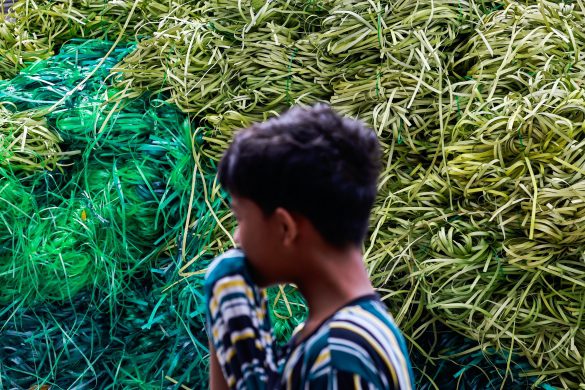Food price volatility a major threat to food security – But no indication of a global food crisis
ROME, 24 September 2010 – Experts from more than 75 FAO Member States agreed Friday that while there were no grounds for complacency (tilfredshed), there was no indication of an impending world food crisis. They proposed exploring new measures to check food price volatility (prisudsving) and manage associated risks.
Concluding a day-long special meeting in Rome the experts recognized that unexpected price hikes (stigninger) “are a major threat to food security” and recommended further work to address their root causes.
The recommendations, put forward by the Inter-Governmental Groups (IGGs) on Grains and on Rice, came as the UN food and agricultural agency issued a report showing that international wheat prices have soared 60-80 percent since July while maize spiked (hoppede) about 40 percent.
Global supply and demand in balance
The meeting said that “Global cereal supply and demand still appears sufficiently in balance”, adding, “unexpected crop failure in some major exporting countries followed by national policy responses and speculative behaviour rather than global market fundamentals have been the main factors behind the recent escalation of world prices and the prevailing high price volatility.”
Among the root causes of volatility, the meeting identified “Growing linkage with outside markets, in particular the impact of ‘financialization’ on futures markets”.
Other causes were listed as insufficient information on crop supply and demand, poor market transparency, unexpected changes triggered by national food security situations, panic buying and hoarding.
Alternative approaches
The Groups therefore recommended exploring “alternative approaches to mitigating food price volatility” and “new mechanisms to enhance transparency and manage the risks associated with new sources of market volatility”.
Some of these issues will be considered at an upcoming meeting of the FAO-based Committee on World Food Security (CFS).
Other IGG proposals included intensifying FAO’s information-gathering and dissemination at all levels. The meeting urged capacity building in areas such as the monitoring of planting intentions, crop development, domestic market information and the different dimensions of futures markets behaviour, including the involvement of non commercial traders.
In conclusion, the meeting recalled that at the 2009 World Summit on Food Security hosted by FAO Member Countries had agreed “to refrain from taking measures that are inconsistent with the WTO rules, with adverse impacts on global, regional and national food security”. It expressed sympathy for countries recently struck by natural disasters.
Crop Prospects
Data on the most recent grains price increases was contained in FAO’s quarterly report on the cereals supply and demand outlook, Crop Prospects and Food Situation, published today.
It forecast 2010 global cereal production at 2.239 million tonnes, only one percent lower than last year and the third largest crop on record. Reduced output of grains in the Commonwealth of Independent States (CIS) countries accounted for most of the decline.
In contrast with the steep increases in wheat (by 60-80 percent) and maize (by 40 percent) prices, the report said rice prices rose by only seven percent from July to September. But even at these higher levels cereal prices were still one third below their peaks in 2008, FAO noted.
Higher cost of cereal imports
The report noted that the cereal import bill for the world’s 77 poorest countries, the Low Income Food Deficit (LIFDC) group, was forecast to increase by 8 percent from 2009-10 to 27,8 billion US dollar as a result of higher international prices.
Hardest hit by higher international wheat prices will be importing countries where wheat is a main staple, the report said. These include countries in the Near East and North Africa – particularly Egypt the world’s biggest importer – CIS Asia and South America.
The impact of higher international wheat prices on consumers will depend on policies in place in individual countries, the report said
Not all countries hit by wheat price hikes
Crop Prospects and Food Situation said that price hikes in the last two months have not been across the board, with prices climbing sharply in some countries but dropping in others, depending on local conditions.
Prices of wheat and wheat flour have already increased markedly in July and August in some LIFDCs, including Afghanistan (24 percent on average), Mongolia (23 percent), Tajikistan (22 percent), Bangladesh (21 percent), Kyrgyzstan (19 percent), and Pakistan (8 percent on average in the first week of September).
In Latin America, prices of wheat flour remained generally stable for the time being. In Mozambique, the increase of 30 percent in the regulated price of bread in early September was revoked by the Government following serious civil disturbances.
Sub-Saharan Africa
Overall, a less immediate impact of the high wheat export prices was foreseen in sub-Saharan Africa, where maize and other coarse grains are the main staples (grundnæringsmidler).
In Eastern and Southern Africa, prices of cereals decreased reflecting 2010 good harvests and were at below pre-food price crisis level. The main exception was Sudan, where despite recent declines prices of sorghum, the main staple, remained at high levels.
In Western Africa prices also declined in early September but remained high particularly in Niger and parts of Chad.
In Asia, price trends for rice, the main food in the region, were mixed. In Bangladesh and Vietnam rice prices increased in August and early September but declined in the Philippines, Thailand and Sri Lanka.
In Central America, prices of the main staple, maize, slightly increased in July but were lower than two years ago.
Kilde: www.fao.org














